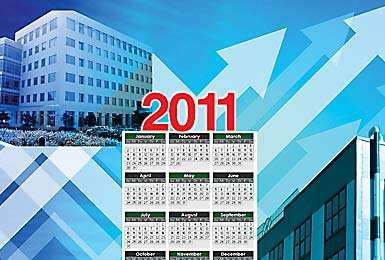Commercial Real Estate 2011: Opportunity Returns
With corporations earning record profits and lease deals still available, opportunity and growth will return to the commercial real estate sector in 2011.
2011 Directory

To some extent, keys have been returned on many buildings, available sub-lease space has been plentiful, and real estate portfolios have been consolidated almost non-stop since 2008. But the hysteria and impending sense of doom has ended. So what happened? Is the end as near as we once thought?
In short, that's not likely. Instead, we have found a new normal in commercial real estate that is not nearly as severe as predicted.
The New Normal
But why? For starters, deals still happen in a recession. Leases expire and are renewed. Landlords have dropped rental rates and added free rent and major work letter concessions. Buildings age and need maintenance, and companies move to more modern or efficient facilities to accommodate changes in business practices and technology. Many states and municipalities pushed business incentives when possible to business retention policies to aid strategic projects.
At this time last year there were very few toes in the water. A bleak 2009 rolled into a 2010 that felt of great malaise (to borrow a term from our last recession) mixed with high unemployment, impending inflation, and low consumer confidence. In 2010, people looked around, but barely outside of, the most pressing and immediate needs within their portfolios.
But 2011 has a different feel. Caution still characterizes the real estate market, but now it seems that there are enough toes in the water that the pool is getting crowded. Things are more positive than many perceive, and competition for space is returning in some instances.
Driving Recovery
Companies are sitting on significant piles of cash, a positive note. Retooling, new operations, and business expansions have been on hold for the last three years. Cost management and headcount reductions - not new market opportunities - have led profits and cost savings over the past several quarters. But now people are getting off of the sidelines partly because they must, as leases expire and machines and buildings require maintenance. The trend is also due to company cost controls that have reached their limits in many budgets. For many companies operating with skeleton crews, budgets can't be trimmed any further.
Mergers and acquisitions activity is gaining traction as executives use acquisition of new businesses as a leading way to grow the bottom line. With valuations down and money still relatively inexpensive, M&A activity will likely drive 2011 real estate transactions. How does that affect the real estate market? Consolidations. As companies are put together and pulled apart, redundancies must be eliminated to justify purchase costs to shareholders, driving transactions at a minimum. Cherry picking facilities within combined portfolios is a major activity, and acquiring additional space or retrofitting and rebuilding at those sites is driving many site selection decisions.
Lower cost real estate alternatives within the portfolio, if they have not already been utilized, will remain a key factor in lessening operating costs. Relocations to cost effective locations also generate activity. This still drives the expansion of manufacturing activities in the Southeast and Southwest.
Project Announcements
Australia-Based Aquatic Leisure Technologies Group Plans Opp, Alabama, Manufacturing Operations
12/11/2025
Teradyne Plans Wixom, Michigan, Robotics Operations
12/11/2025
Robinson Plans Altoona, Iowa, Manufacturing Operations
12/11/2025
BioTouch Expands Columbus, Georgia, Operations
12/11/2025
Natrion Plans Erie County, New York, Battery Components Operations
12/11/2025
Czech-Based GZ PrintPak Expands Mount Pleasant, Wisconsin, Manufacturing Operations
12/11/2025
Most Read
-
The Workforce Bottleneck in America’s Manufacturing Revival
Q4 2025
-
Rethinking Local Governments Through Consolidation and Choice
Q3 2025
-
Lead with Facts, Land the Deal
Q3 2025
-
How Canada Stays Competitive
Q3 2025
-
Investors Seek Shelter in Food-Focused Real Estate
Q3 2025
-
America’s Aerospace Reboot
Q3 2025
-
The Permit Puzzle and the Path to Groundbreaking
Q3 2025
